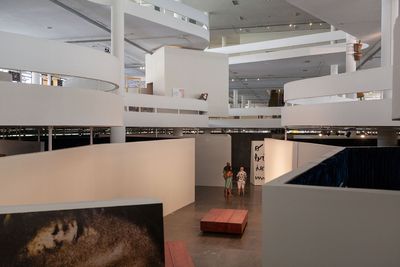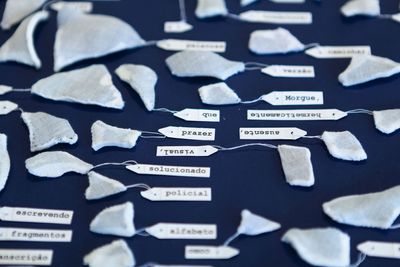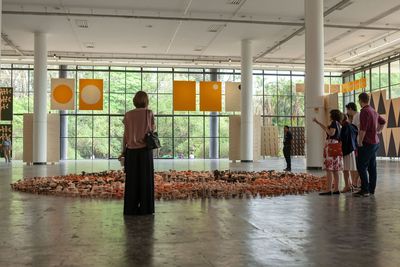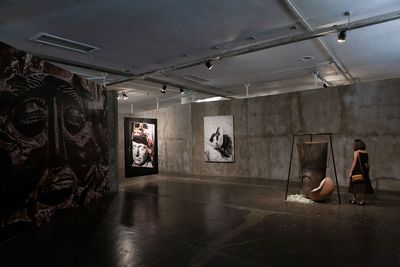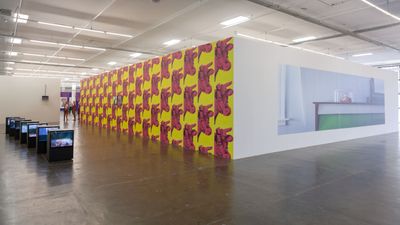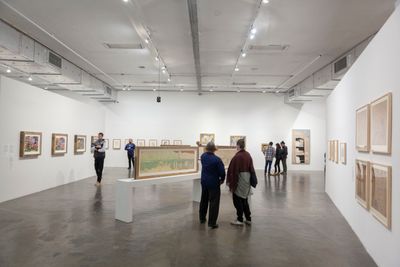33rd Bienal de São Paulo: Affective Affinities

Exhibition view: The Slow Bird, curated by Claudia Fontes at the 33rd Bienal de São Paulo: Affective Affinities (7 September–9 December 2018). Courtesy Bienal de São Paulo Foundation. Photo: © Pedro Ivo Trasferetti / Bienal de São Paulo Foundation.
Founded in 1951, the Bienal de São Paulo is the second oldest biennial in the world after the Venice Biennale, which was founded in 1895. Today, the Bienal sits comfortably as the largest art exhibition in the Southern Hemisphere: the 2016 edition received over 900 thousand visitors, and the event has been credited with generating approximately 300 million Brazilian Reals' worth of business for the city.1 Throughout its history, the exhibition has undergone several changes, with a focus on national representation remaining the paradigm until its 18th edition, when Sheila Leirner curated O homem e a vida. For the 2008 show In Living Contact, curators Ivo Mesquita and Ana Paula Cohen left the second floor of the Bienal pavilion entirely empty; a gesture that translated into a metaphor for the conceptual crisis facing traditional exhibition systems.
For its 33rd edition (7 September–9 December 2018), Spanish curator Gabriel Pérez-Barreiro has challenged the single-curator system by inviting seven artists—Sofia Borges, Waltercio Caldas, Alejandro Cesarco, Claudia Fontes, Antonio Ballester Moreno, Mamma Andersson, and Wura-Natasha Ogunji—to organise exhibitions in dialogue with their own practices. These artist-organised shows are presented in delineated spaces—described by exhibition designer Alvaro Razuk as islands in an archipelago—within the 25000-metre-square Oscar Niemeyer-designed Ciccillo Matarazzo Pavilion, alongside 12 individual projects curated by Pérez-Barreiro.
Three of these projects by Pérez-Barreiro are posthumous tributes to artists Aníbal López, Feliciano Centurión, and Brazilian-born, London-based Lucia Nogueira, who died at the age of 48 in 1998. A set of Nogueira's sculptures and installations present a small retrospective, showcasing the artist's use of everyday objects to create delicate and unsettling compositions, like pillows (At Will and the Other, 1989), tables (No Time for Commas, 1993), and rugs (Step, 1995). Offering another historical view is living artist Siron Franco, whose series of historic paintings ('Césio') and drawings ('Rua 57') from 1987 document an incident in September that year in the city of Goiânia, a few blocks away from where the artist once lived, when the dislodging of a toxic cesium 137 from an X-ray machine discovered in an abandoned lot triggered a nuclear emergency ranked second only to Chernobyl. The other eight artists in Pérez-Barreiro's section of the show created new commissions, including Bruno Moreschi's Another 33rd São Paulo Biennial, a website that offers a platform for viewers to engage with the Bienal beyond its official curatorial statements.
With a total of 103 artists and approximately 600 works, the Bienal's title, Affective Affinities, reflects on this edition's non-thematic model. It references renowned art critic Mario Pedrosa's thesis, 'Of the Affective Nature of Form in the Work of Art' (1949), which states that art should be judged primarily by its ability to inspire a direct relation between an artist's intention and a viewer's sensibility; and Johann Wolfgang von Goethe's 1809 novel Elective Affinities, which follows a couple's relationship between themselves and others, and considers the influence of the sciences on empathy and feeling.
As a whole, Affective Affinities considers affinity and affect as a means to engage with art beyond rigid conceptual frames. In the case of Claudia Fontes' presentation The Slow Bird, for example, an expanded temporality is offered through a variety of artworks that activate links between art, literature, and translation. Fontes' curatorial take is a sort of dismembered text, as reflected in the artist's own work, Footnote (2018), which is included in this grouping, alongside works by artists like Ben Rivers and Daniel Bozhkov—small fragments of ceramics labelled with words in Spanish such as 'absent', 'pleasure', and 'solved'.
The first artist-organised exhibition that the visitor encounters after entering the pavilion is Spanish painter Antonio Ballester Moreno's common/sense, which opens with a group of Moreno's colourful acrylic paintings on jute depicting shapes of natural elements, such as trees, the rain drops, and the sun. These paintings form part of the installation Vivan los campos libres de España (2018); they are hung on the building's glass windows, and are presented alongside thousands of clay mushrooms made with children from five schools in São Paulo and workers at the Bienal.
Vivan los campos libres de España creates a dialogue with the vegetation of Ibirapuera Park outside, and introduces this show's theme: the relationship between man and nature. An eclectic group of works include wooden educational toys created by revolutionary German philosopher and educator, Friedrich Fröbel (1782–1852), as well as works by contemporary artists including Mark Dion, who developed a workshop with Brazilian artists within Ibirapuera Park, whereby participants studied plants, little animals, and objects found around the park, and documented them in watercolour studies. These paintings hang on wooden screens inside the pavilion, with each illustration identified with a seal and the author's name. The result, Estação de Campo Parque do Ibirapuera (Field Station Ibirapuera Park) (2018), is a beautiful collection of elements that recount a visual history of the park.
Staged on the first floor of the pavilion is The Infinite History of Things or the End of the Tragedy of One, curated by Sofia Borges—by far the largest exhibition on show, with some 200 works in total. Organised like a labyrinth, with two mirrored corridors lined with heavy velvet curtains, the show explores death, life, and myth, with large-scale photographs of ancient Greek theatre masks, and black and white representations of indigenous rituals, showing painted bodies and faces, by Martin Gusinde setting the tone.
Borges' exhibition does away with labels or wall texts, which creates a sense of a Gesamtkunstwerk. Nevertheless, one can recognise Brazilian sculptor Tunga's organic forms in reddish tones suspended by thin, stark black poles (Sem título, 2014) from the series 'From La Voie Humide' (2014) and Sarah Lucas' Tit-Cat Up (2015)—a black feline figure from which large, breast-like orbs droop downwards. Also included are Sara Ramo's floor sculptures made from dental stone and pigment from the series 'Matriz e a Perversão da Forma (Matrix and the Perversion of Form)' (2015), resembling large, hollowed, and halved gemstones or fruits with pink, orange and green interiors. These sculptures are actually molds, from the masks the artist conceived for the characters on her video Os Ajudantes (The Helpers) (2015), and they add another element to this labyrinth of tragedies. Paintings from Rio de Janeiro's Museu de Imagens do Inconsciente (Images of the Unconscious Museum), an institution which houses drawings and paintings by psychiatric patients created in 1952 by Doctor Nise da Silveira, are also on view.
As an investigation into the limits of representation, Borges' show is partially re-organised each week by some of the participating artists, with paintings placed in different positions or swapped around, which responds to the Bienal's theme of affective affinities. Likewise, To Our Parents, organised by Alejandro Cesarco on the second floor of the pavilion, takes on the challenge of producing open yet affective connections and dissonances in a cross-generational take. This essay of a show thinks about how 'a primary relation (biological or adopted, literal or metaphorical) is a way of constructing a genealogy'. Drawing on issues such as repetition, narrative and translation, the exhibition includes Cesarco's Studies for a Series on Love (Wendy's Hands) (2015): two photographs showing open hands that have been placed on two opposite walls, as if to hug the exhibition space.
In many ways, this idea of an open embrace fits with the artist-organised projects in the Bienal, in which eclectic connections are drawn out, often in unexpected ways. On the third floor, Stargazer II, organised by Mamma Andersson, brings together a group of artists that have influenced Andersson's practice as a painter, mainly through a common interest in expressive figuration and the human body. The project draws in a wide range of time-frames and approaches, with works by self-taught artist Henry Darger placed alongside 15th-century Russian icons, for example. Andersson's paintings, rarely seen in Brazil, include the eerie Pigeon House (2010), which depicts three figures sitting at a table in a stark interior, who seem oddly unaware of one another's presence.
Indeed, despite Pérez-Barreiro's admirable intention to avoid heavy-handed curatorial control, the figure of the curator does not disappear in this edition of the Bienal de São Paulo completely; rather, it divides the undertaking up between individuals. While some projects are indeed interesting curatorial experiments, the lack of an overarching curatorial line—beyond the intuitive connections viewers might reach on their own—results in a lack of dialogue among the various artist interventions. The risk is that each component of the Bienal remains self-enclosed.
Furthermore, with the Bienal de São Paulo opening on the same day as Brazil's Independence's day, and just a month prior to the country's presidential elections amidst political scandal and economic chaos, the lack of a contextually focused political argument felt like a missed opportunity to connect with Brazil's social context, in which this exhibition operates. Such missed connections point to the issue when it comes to the relationship between art and politics, not to mention the relations between those who participate in either practice: both should walk together. —[O]
—
1 Source: www.bienal.org.br/aboutus

